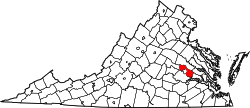History
Called "Mountain Road Crossing" when rail service began in 1836, the settlement which came to be known as Glen Allen took its name from the homestead of a local landowner, Mrs. Benjamin Allen. Its most noted resident was Captain John Cussons, a native Englishman, Confederate scout, author, and entrepreneur. Cussons made his residence here after the Civil War and founded a successful printing company. Later, he built a fashionable resort hotel adjacent to the railroad tracks, which was known as Forest Lodge. [4]
Glen Allen used to be mostly rural farmland, but it is now a growing suburb of Richmond.
Geography
According to the United States Census Bureau, the CDP has a total area of 8.86 square miles (22.94 km2), of which 8.79 square miles (22.77 km2) are land and 0.069 square miles (0.18 km2), or 0.76%, are water. [3]
The Glen Allen census-designated place is in northern Henrico County, approximately 11 miles (18 km) north-northwest of downtown Richmond. The CDP is bordered to the north by the Chickahominy River, which forms the Henrico–Hanover County line. The eastern border of the CDP is Interstate 95, from the Chickahominy River south to East Parham Road. The southern border of the CDP follows East Parham Road, U.S. Route 1, Virginia State Route 157 (Mountain Road), Jessie Chavis Drive, North Run, Woodman Road, Blackburn Road, Winston Boulevard, and Indale Road to the CSX railroad line, which it follows south to Hungary Road. The western border of the CDP follows Hungary Spring Road, Old Route 33, Attems Way, and U.S. Route 33 (Staples Mill Road) to Courtney Road, then follows a power line northeast back to the CSX rail line. The border follows the railroad north to County Road 625 (Greenwood Road), then takes Old Washington Highway to the Chickahominy River. [5] Glen Allen uses two postal addresses, ZIP codes 23059 and 23060, which cover neighboring communities as well, including rural areas of Hanover County to the north.
The Glen Allen CDP includes all or portions of the communities of Hunton, Greenwood, Longdale, Holly Glen Estates, Biltmore, and Yellow Tavern. [6]
Demographics
Historical population| Census | Pop. | Note | %± |
|---|
| 1980 | 6,202 | | — |
|---|
| 1990 | 9,010 | | 45.3% |
|---|
| 2000 | 12,562 | | 39.4% |
|---|
| 2010 | 14,774 | | 17.6% |
|---|
| 2020 | 16,187 | | 9.6% |
|---|
|
As of the census [8] of 2020, there were 16,187 people, up from 14,774 at the 2010 Census.The racial makeup of the CDP was 60.4% White, 25.3% African American, 0.0% Native American, 7.5% Asian, 0.0% Pacific Islander, and 2.4% from two or more races. Hispanic or Latino of any race were 6.4% of the population.
The median income for a household in the CDP was $79,401. The per capita income for the CDP was $39,414. About 7% of the population were below the poverty line.
This page is based on this
Wikipedia article Text is available under the
CC BY-SA 4.0 license; additional terms may apply.
Images, videos and audio are available under their respective licenses.


